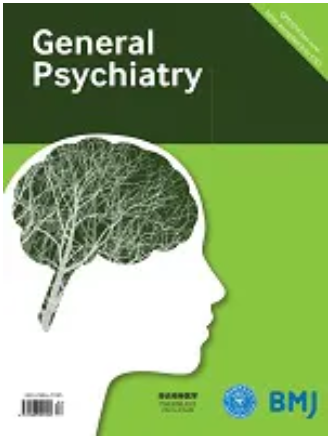Thirty-year trends of anxiety disorders among adolescents based on the 2019 Global Burden of Disease Study
IF 5.3
3区 医学
Q1 PSYCHIATRY
引用次数: 0
Abstract
Background Anxiety disorders are the most common psychiatric problems, affecting approximately 1 in 12 children and 1 in 4 adolescents. Understanding the incidence, burden and correlated risks of anxiety disorders among children and adolescents can help identify areas of success, stagnation and emerging threats, thereby facilitating effective improvement strategies. Aims To estimate the incidence and burden trends of anxiety disorders in children and adolescents from 1990 to 2019 in 204 countries and compare the incidence and disease burden in different countries. To examine the association between anxiety disorders and social indicators (healthcare access and quality of life). Methods Data were obtained from the Global Burden of Disease Study 2019. The age-standardised incidence rates (ASIRs) and disability-adjusted life years (DALYs) were reported to assess the burden of anxiety disorders, and the estimated annual percentage change was calculated to quantify the temporal trends. Pearson’s correlation was used to investigate country-level risk factors for incidence and DALYs. Results Globally, there were 932 million incident cases of anxiety disorders in children and adolescents, 739.29 per 100 000 ASIRs and 380.62 million DALYs in 2019. From 1990 to 2019, the estimated annual percentage change of incidence of anxiety disorders decreased by 2.2%. Significant variations were observed in the age-standardised burden rate and the changing trend of anxiety disorders among countries. Portugal reported the highest ASIR of anxiety disorders, while Mexico had the largest increase rate of ASIR. In 2019, Portugal reported the highest number of DALYs (1001.71 million), and India (212.09 million) reported the lowest number of DALYs. The burden of anxiety disorders was positively correlated with the average number of psychiatrists, psychologists and nurses in the mental health sector (per 100 000), and quality of life and the correlation coefficients were 0.58, 0.67, 0.43 and 0.53, respectively. Conclusions The incidence and global burden of anxiety disorders in adolescents have continued to decrease over the past 30 years. However, the incidence and disease burden in developed countries are still increasing steadily. Policymakers should design and implement mental health strategies for adolescents based on their specific developmental status, as well as the cultural and regional characteristics of each country. Data are available in a public, open access repository. The GBD database provides a tool to quantify health loss from hundreds of diseases, injuries and risk factors.The data can be reused by registering on the website:基于《2019 年全球疾病负担研究》的青少年焦虑症三十年发展趋势
背景 焦虑症是最常见的精神问题,每 12 名儿童和每 4 名青少年中分别约有 1 人和 1 人患有焦虑症。了解焦虑症在儿童和青少年中的发病率、负担和相关风险有助于确定成功、停滞不前和新出现威胁的领域,从而促进有效的改进策略。目的 估计 1990 年至 2019 年 204 个国家儿童和青少年焦虑症的发病率和负担趋势,并比较不同国家的发病率和疾病负担。研究焦虑症与社会指标(医疗保健的可及性和生活质量)之间的关联。方法 数据来自《2019 年全球疾病负担研究》。报告了年龄标准化发病率(ASIRs)和残疾调整生命年(DALYs),以评估焦虑症的负担,并计算了估计的年度百分比变化,以量化时间趋势。采用皮尔逊相关性来研究发病率和残疾调整寿命年数的国家级风险因素。结果 2019 年全球儿童和青少年焦虑症发病病例为 9.32 亿例,每 10 万例 ASIR 为 7.39.29 例,残疾调整寿命年数为 3.8062 亿年。从 1990 年到 2019 年,焦虑症发病率的估计年百分比变化下降了 2.2%。焦虑症的年龄标准化负担率和变化趋势在各国之间存在显著差异。葡萄牙报告的焦虑症年龄标准化负担率最高,而墨西哥的焦虑症年龄标准化负担率增长率最高。2019年,葡萄牙报告的残疾调整寿命年数最高(1.0171亿),印度(2.1209亿)报告的残疾调整寿命年数最低。焦虑症的负担与精神卫生部门的精神科医生、心理学家和护士的平均人数(每 10 万人)以及生活质量呈正相关,相关系数分别为 0.58、0.67、0.43 和 0.53。结论 在过去 30 年中,青少年焦虑症的发病率和全球负担持续下降。然而,发达国家的发病率和疾病负担仍在稳步上升。政策制定者应根据青少年的具体发展状况以及各国的文化和地区特点来设计和实施青少年心理健康战略。数据可在公开、开放的资源库中获取。GBD 数据库为量化数百种疾病、伤害和风险因素造成的健康损失提供了一个工具。
本文章由计算机程序翻译,如有差异,请以英文原文为准。
求助全文
约1分钟内获得全文
求助全文
来源期刊

General Psychiatry
医学-精神病学
CiteScore
21.90
自引率
2.50%
发文量
848
期刊介绍:
General Psychiatry (GPSYCH), an open-access journal established in 1959, has been a pioneer in disseminating leading psychiatry research. Addressing a global audience of psychiatrists and mental health professionals, the journal covers diverse topics and publishes original research, systematic reviews, meta-analyses, forums on topical issues, case reports, research methods in psychiatry, and a distinctive section on 'Biostatistics in Psychiatry'. The scope includes original articles on basic research, clinical research, community-based studies, and ecological studies, encompassing a broad spectrum of psychiatric interests.
 求助内容:
求助内容: 应助结果提醒方式:
应助结果提醒方式:


